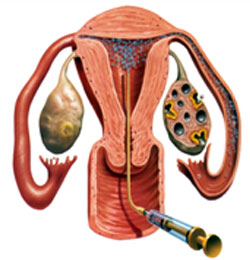As the name implies Intra-uterine insemination is a procedure involving the insemination of a prepared sperm sample directly into the uterus at the time of ovulation. The technique is also known artificial insemination.
When should IUI be used?
IUI treatment is usually offered in cases where there is a relatively low sperm count (oligspermia), reduced sperm movement (motility) or in instances where there is doubt that the sperm may fail to pass into the Fallopian tube where in normal circumstances it meet the egg and fertilises it.
What does treatment involve?

The insemination procedure involves depositing sperm directly into the uterus using a fine catheter which is inserted through the cervix via the vagina. To maximise chances the ovaries are stimulated with fertility medications to produce more than one egg. As the timing of the insemination is crucial, the woman's ovaries are monitored using ultrasound scans to assess the development of the follicles (the sacs in which the eggs grow). When the follicle(s) reaches the appropriate size a hormone injection is given to trigger ovulation and then the sperm is inseminated some 36 to 40 hours later.
The husband is required to attend the clinic on the day of the insemination and produce a semen sample which is prepared in the laboratory to extract the most motile sperm. A pregnancy test should be performed two weeks after the insemination.


